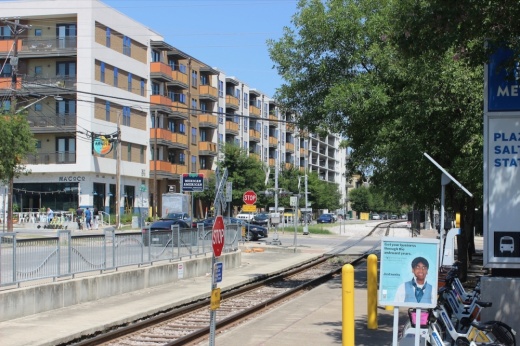The big picture
City Council voted to fast-track several policy changes in early February tying into issues such as improved transit access and walkability around new developments, promoting affordable housing, and allowing more housing to be built in Austin.
Many of the council-directed updates stem from the city's equitable transit-oriented development, or ETOD, policy planning. The stated intention of Austin's ETOD blueprint is to help guide development with a focus on affordability, accessibility and equity in communities around dozens of rail and bus stations.

After advancing that future development framework a year ago, City Council passed a new round of ETOD plans along with other land-use requests in a 10-1 vote Feb. 1.
"As a city and a body, we need to continue to think big and start pursuing more ambitious affordability and sustainability goals," Council Member José Velásquez said. "Deeply affordable multifamily housing with access to reliable public transit is the only way we can work to minimize the rampant displacement of lower- and middle-income Austinites. We’re seeing this across the city, but particularly along the Eastern Crescent here, we have an opportunity to be specific about what is needed—and that is an affordable, walkable, connected city for the people and families that need it most."
The details
A central piece of that package was the move toward creating an "ETOD overlay," or transit-supportive regulations for properties located near station areas. That zoning overlay could unlock options for taller, denser buildings—up to 120 feet or more—with a focus on added housing, and incentivize the inclusion of affordable spaces and other community benefits in new construction.
City staff will now look to rezone properties within a half-mile of planned Project Connect rail stations under that overlay.
Council amended the ETOD item to support ground-floor retail and community uses in projects situated near transit lines, encourage developers to add "transit supportive features" in those places, and other priorities.
The council resolution also asked to consider how local development pressures contributing to displacement might increase in places around bus and rail stops. Planning department staff said that focus is intended to support policies that bring more affordable residences closer to transit.
"Development pressures often come with increased investment in public transportation infrastructure, as can be seen nationally in other communities that have constructed high-capacity transit. In Austin, we hope to learn from the experiences of other cities and proactively consider displacement risks when planning for ETOD," staff said in an email.
Other concepts accelerated by council Feb. 1 included:
- Updating the East Riverside Corridor Regulating Plan in line with the ETOD framework and Project Connect's planned path down Riverside Drive
- Revising downtown parking regulations to potentially limit the amount of parking included in new high-rise development
- Creating a new affordable housing bonus program that would trade added building height for income-restricted housing through rezoning—a replacement for the court-voided VMU2 program adopted in 2022
"The code amendments ... are targeted efforts that build on existing policy and regulations, and also complement other recent council action, such as eliminating motor vehicle parking minimums citywide and initiating changes to citywide compatibility," staff said.
Digging in deeper
In addition to aligning with many elected officials' goals for Austin development policies, cementing the proposed changes is also viewed as a critical step before billions of federal dollars needed for the 10-mile Project Connect rail system can be secured.
Project Connect's initial phase is in the early stages of a mandated environmental review, which the public can weigh in on through March 4. At the same time, design work for the rail program is continuing as the entities involved plan to apply for the federal funding that's expected to cover around half of the project's price tag.
Austin's scoring on Federal Transit Administration benchmarks for topics such as land use and economic development around transit routes could hinge on updates like those now being taken up by city planners.
"The changes outlined in staff’s transit-supportive code amendments proposal are essential for Austin to be competitive for the federal funding necessary to fulfill our community’s light rail vision, a vision which is itself essential to meeting Austin’s affordability, equity, mobility and climate goals," staff said. "Allowing for increased density near transit means more people can access opportunities. Incentivizing affordable housing and other community benefits improves the quality of life for all Austinites, not just those of more means."
Project Connect's preliminary ratings package will be submitted to the FTA this summer. An initial evaluation could be returned by next spring.
Quote of note
"These new density policies are essential for Austin to be competitive for the billions in federal funding needed to realize the voters’ vision for light rail. And light rail, in turn, is essential to realizing our community priorities for housing and affordability as well as climate and environmental protection," Mayor Kirk Watson wrote in a February newsletter. "To fully address our city’s affordability emergency and close the intergenerational equity gap, we need to look at how we can combine transit-supportive density policies and our affordability objectives together."





